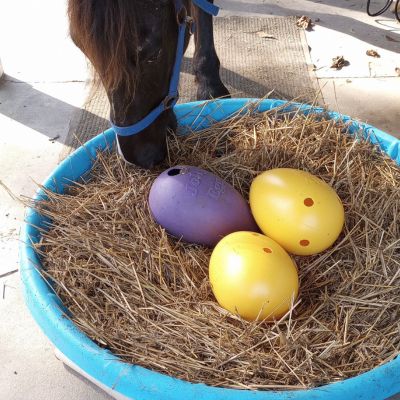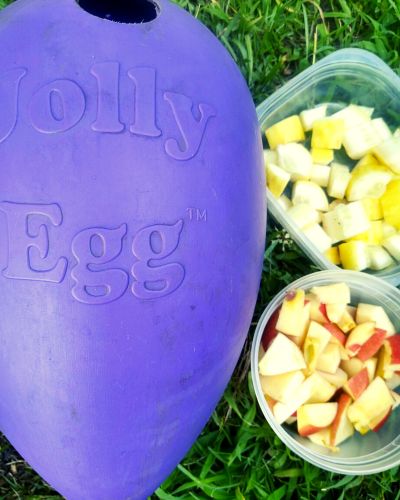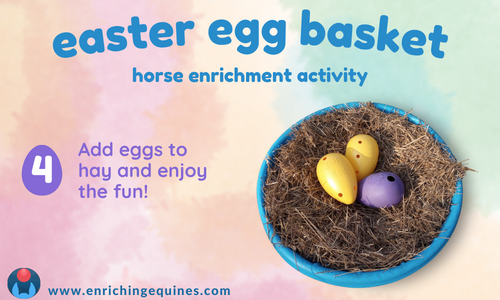
This incredibly cute DIY enrichment activity is perfect for all horses. Using some hollow eggs, straw, and a basket or pool you can create a treat-filled, boredom busting Easter basket! This equine enrichment offers mental stimulation, variety, and encourages slow feeding. Here’s how to make your very own Easter egg basket for horses, step by step.
What’s the DIY Easter Egg Basket for Horses?
The concept behind this DIY enrichment for horses is simple: make an Easter basket. The eggs are hollow, rolling treat balls that you’ll fill with treats or feed. They rest in a basket lined with soft straw or hay. It’s a classic Easter egg basket complete with multicolored eggs – but it’s also a treat puzzle!

How Does the Easter Basket for Horses Provide Enrichment?
Enrichment for your horse is all about encouraging natural behaviors. It might not seem like there’s anything “natural” about giving your equine friend their very own Easter basket, but look a little closer and you’ll find a ton of behavior benefit and boredom busting potential.

The basket itself is full of hay or straw, plus hidden goodies (you can use treat items, or a scatter of feed). To get the tasty goodies, your horse will explore and snuffle through the higher-fiber forage. This is the same concept behind the forage box, one of the easiest – and cheapest! – horse enrichment items out there.
But the Easter basket for horses ups the ante by including eggs. They’re Jolly Eggs, to be exact – actually made for dogs. We’ve covered how to turn a Jolly Egg into a rolling treat ball before and this toy is a consistent favorite. You add feed or treats to the eggs, and this creates a fabulous food puzzle. To make the snacks fall out, the horse has to nudge and push the ball around.
Enrichment Value of the Easter Basket
So to recap, this cute DIY offers a surprising amount of behavioral value. It encourages all of these:
- Exploring and using the senses
- Problem solving
- Eating slowly
- Selecting food choices (picking the treats out of the hay)
- Fine motor control and dexterity
And to cap it off, this activity is long-lasting and, for many horses, safe for unsupervised use.

How to Make the DIY Easter Basket Enrichment for Horses
Making this equine enrichment activity involves two main steps: the basket portion, and making/filling the eggs.
Supplies and Materials
- Large shallow basket, pan, or kiddie pool
- Hay or straw
- Jolly Egg(s)
- Drill and hole saw
- Treats and/or feed
Jolly Eggs are available from Amazon. You can find them in large (pictured) and medium sizes here.

Because I’m using three large eggs, a normal basket wouldn’t cut it (the egg would just get pushed all the way out). So for this tutorial I’m using the humble but mighty kiddie pool. If you don’t have a kiddie pool in your enrichment arsenal yet, they’re a star player. Check out this article of many more ways to use them for equine enrichment!
You can use any horse-safe food for both the basket and eggs. I like to mix and match, placing smaller dry treats or pellets in the eggs and larger pieces of fruit or veggie in the basket.

Step 1. Make the Jolly Easter Eggs

You’ll need a hole saw attachment or a very wide drill bit, plus cordless drill, for this project.
Hole saws are easy to use – they’re just like using a regular drill bit, but make a much larger hole. You can find single hole saws at hardware stores on on Amazon, like this basic 3/4″ saw attachment for about $10.

The location, size, and number of holes affects the difficulty level of your Jolly Egg. Lots of holes means the treats come out faster; same with bigger holes. By contrast, smaller holes and holes placed toward the ends of the egg make for a more challenging toy.

Mark the locations of your holes and carefully drill the holes, cleaning the plastic from the hole saw between each one.
With the holes completed, it’s time to turn your attention to the basket itself.
Step 2. Make the Equine Easter Basket

You can use straw or hay for the basket portion of this enrichment project.
Straw is a great high-fiber, low-calorie choice for for horses on very controlled diets, and for donkeys or mules. Straw is edible, though most equines prefer to pick through it rather than vacuuming it up. Hay is also a great choice and is readily available.
Scatter the hay or straw loosely into the basket. Break up flakes by hand so that the forage is loose and fluffy.
Step 3. Add Treats to Your Easter Egg Basket

Carefully add feed or treats to the Jolly Eggs, holding the egg over a pan so that you can catch bits that miss the holes. You can also use a basic kitchen funnel to make loading the treats faster.
Sprinkle goodies throughout the hay/straw, leaving them on top for first-timers or fluffing them into the forage for more experienced puzzle solvers.
Lastly, place the eggs into the basket to complete your ultra-cute Easter themed enrichment basket! Your DIY Easter egg basket for horses is ready to be enjoyed.

Easter Egg Basket for Horses Safety and Use
Safety is always of prime importance when working with equine enrichment.
Always supervise enrichment activities for the first few sessions, and don’t leave enrichment unsupervised unless you know the item is safe and your horse uses it appropriately.
After some observation, though, this enrichment activity is usually appropriate for unattended use – if you can stand to leave while so much fun is going on! Your horse will probably have a fantastic time right away, nosing through the forage or figuring out how the Jolly Eggs work.
If they don’t seem to understand, try a few sessions with the basket and the eggs set up separately so that your horse can figure out how each enrichment operates. And don’t miss this article on how to teach your horse how to use enrichment.
It’s unlikely that your horse will be scared of this enrichment activity, but be sure to introduce it in an open area where the horse is free to explore and leave. When you know they’re comfortable and are not afraid of the enrichment, you can use it in their stall. (If they are scared, there’s an article on solving that, too).
Related Enrichment
Try these ideas for similar items, activities, or behavior goals: